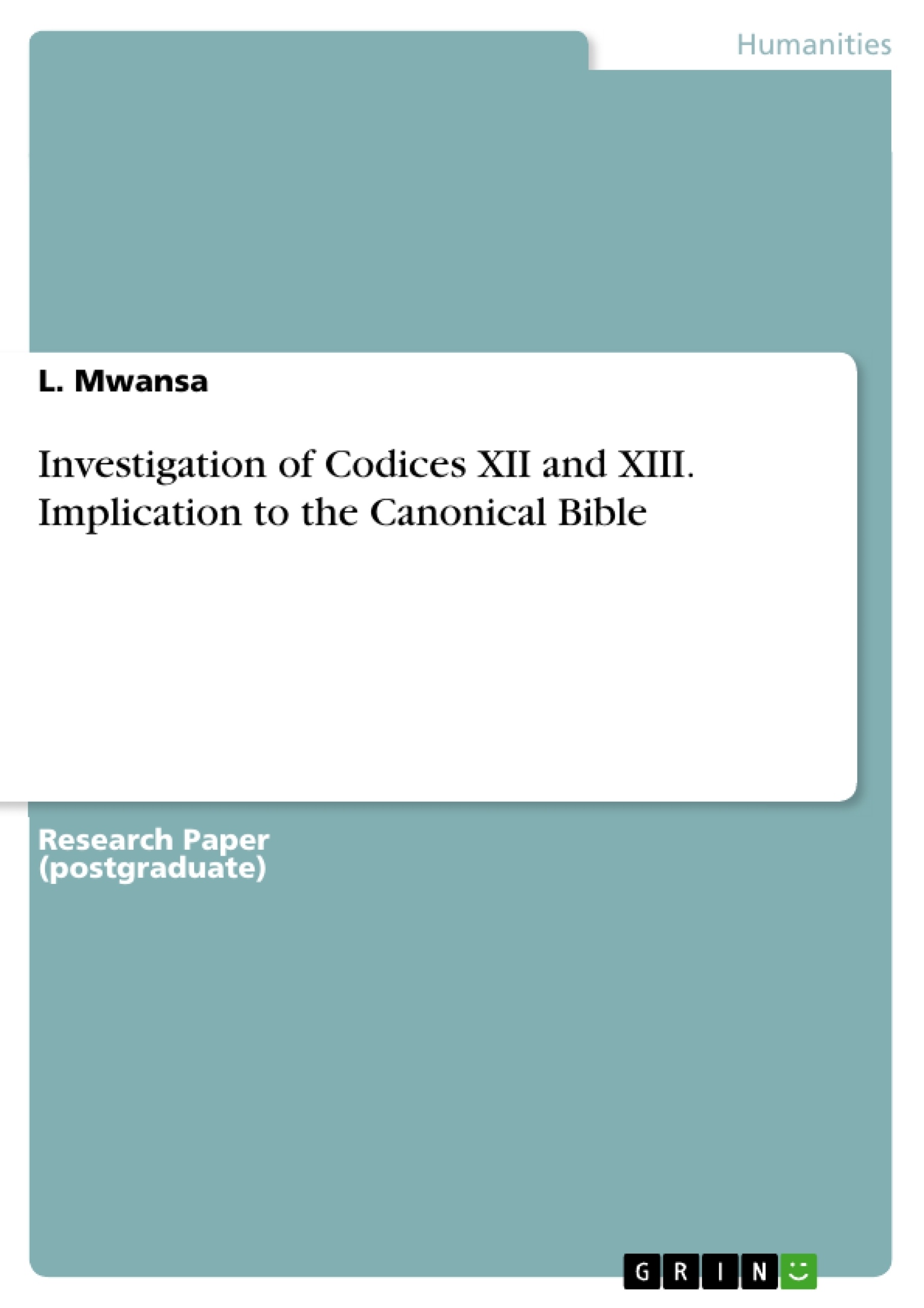This paper deals with the investigation of the inherent implications of Codices XII and XIII to the Canonical Bible.
According to Charles Hedrick, Codex XII was part of one of the groups of codices possessed by the antiquities dealer Phocion J. Tano during 1946 to 48. It was preserved at the Department of Antiquities in 1949, taken to the Coptic Museum on 9 June 1952 and stated national property by court action in 1956, and was given the inventory number 10555 in 1959. In 1949 it had been numbered XII by Jean Doresse and Togo Mina, in 1950 numbered XIII by Henri Charles Puech, since 1958 it was numbered XI by Doresse, and in 1962 was numbered XII by Martin Krause and James M. Robinson.
In April 1961 it was preserved in 12 plexiglass containers by Victor Girgis in consultation with Pahor Labib and Martin Krause. Photographs were taken by R. Herzog for Krause at that time, and once more by photographers of the Center of Documentation for UNESCO in 1966. fragments were set and photographs taken at three work sessions during 1970 to 71 under the supervision of the Technical Sub Committee of the International Committee for the Nag Hammadi Codices of the Arab Republic of Egypt and UNESCO. Of all the Nag Hammadi Codices, Codex XII is in the poorest condition of conservation. There are no titles or page numbers remaining, although at least three discourses are depicted. Of the about thirty nine original pages of the Sentences of Sextus (XIl,1) ten survive, of which eight miss parts of the top and bottom lines, but the remaining two (from a separate part of the discourse) have lost the outside half of the leaf.
Of the originally twenty nine pages of The Gospel of Truth (XIl, 2) has fragments of only six. Until the two larger remaining fragments {numbers I and 2 on pl. 101 to 102 of the Facsimile publication: Codices XI, XII, XIII) can be connected with a familiar piece of literature, it is impossible to say whether; they depict one or two other discourses (Charles 289). Since the remnants come from different parts of the codex, it is possible that the principal loss was suffered since the discovery in modem times. The initial size of the codex cannot be restored. The estimated initial lengths of the Sentences of Sextus and the Gospel of Truth with the four pages of a third discourse, for which evidence remains, sums up to a minimum of seventy-two pages. The third discourse, nevertheless, was almost certainly longer than four pages.
Inhaltsverzeichnis (Table of Contents)
- Investigation of the inherent implications of Codices XII and XIII to the Canonical Bible
- Codex XII: Its History and Current State
- Codex XII: The Sentences of Sextus
- Codex XII: The Gospel of Truth
- Codex XII: The Third Discourse
- The Significance of Codex XII and its Relationship to the Canonical Bible
- Codex XIII: Its History and Current State
- Codex XIII: The Gospel of Truth
- Codex XIII: The Third Discourse
- The Significance of Codex XIII and its Relationship to the Canonical Bible
Zielsetzung und Themenschwerpunkte (Objectives and Key Themes)
This essay undertakes a thorough investigation of the inherent implications of Codices XII and XIII to the Canonical Bible. It aims to analyze the content and significance of these codices, exploring their potential impact on our understanding of early Christianity and the formation of the New Testament canon.
- The historical context and significance of Codices XII and XIII
- The content and structure of the discourses within Codices XII and XIII, particularly the "Sentences of Sextus" and the "Gospel of Truth"
- The relationship between the discourses within these codices and the Canonical Bible
- The potential impact of these codices on our understanding of early Christianity and the development of Gnosticism
- The implications of these codices for biblical studies and the interpretation of the New Testament
Zusammenfassung der Kapitel (Chapter Summaries)
- The first chapter provides an overview of the history and current state of Codex XII. It describes the codex's journey through various institutions and the challenges faced in its preservation and analysis. The chapter also discusses the unique physical characteristics of Codex XII, including its quire formation and the difficulties in determining the original order of its discourses.
- The second chapter focuses on the "Sentences of Sextus," a discourse preserved in Codex XII. It explores the content and themes of this discourse, highlighting its potential connections to other early Christian and Gnostic texts.
- The third chapter delves into the "Gospel of Truth" found in Codex XII. It examines the discourse's content, structure, and its relationship to the canonical Gospels. The chapter also analyzes the potential significance of the "Gospel of Truth" for our understanding of early Christian beliefs and practices.
Schlüsselwörter (Keywords)
The key terms and focus topics of this work include Codices XII and XIII, the "Sentences of Sextus," the "Gospel of Truth," early Christianity, Gnosticism, biblical studies, New Testament canon, textual criticism, and the historical and theological significance of early Christian writings.
- Citation du texte
- Dr. L. Mwansa (Auteur), 2023, Investigation of Codices XII and XIII. Implication to the Canonical Bible, Munich, GRIN Verlag, https://www.grin.com/document/1385970



